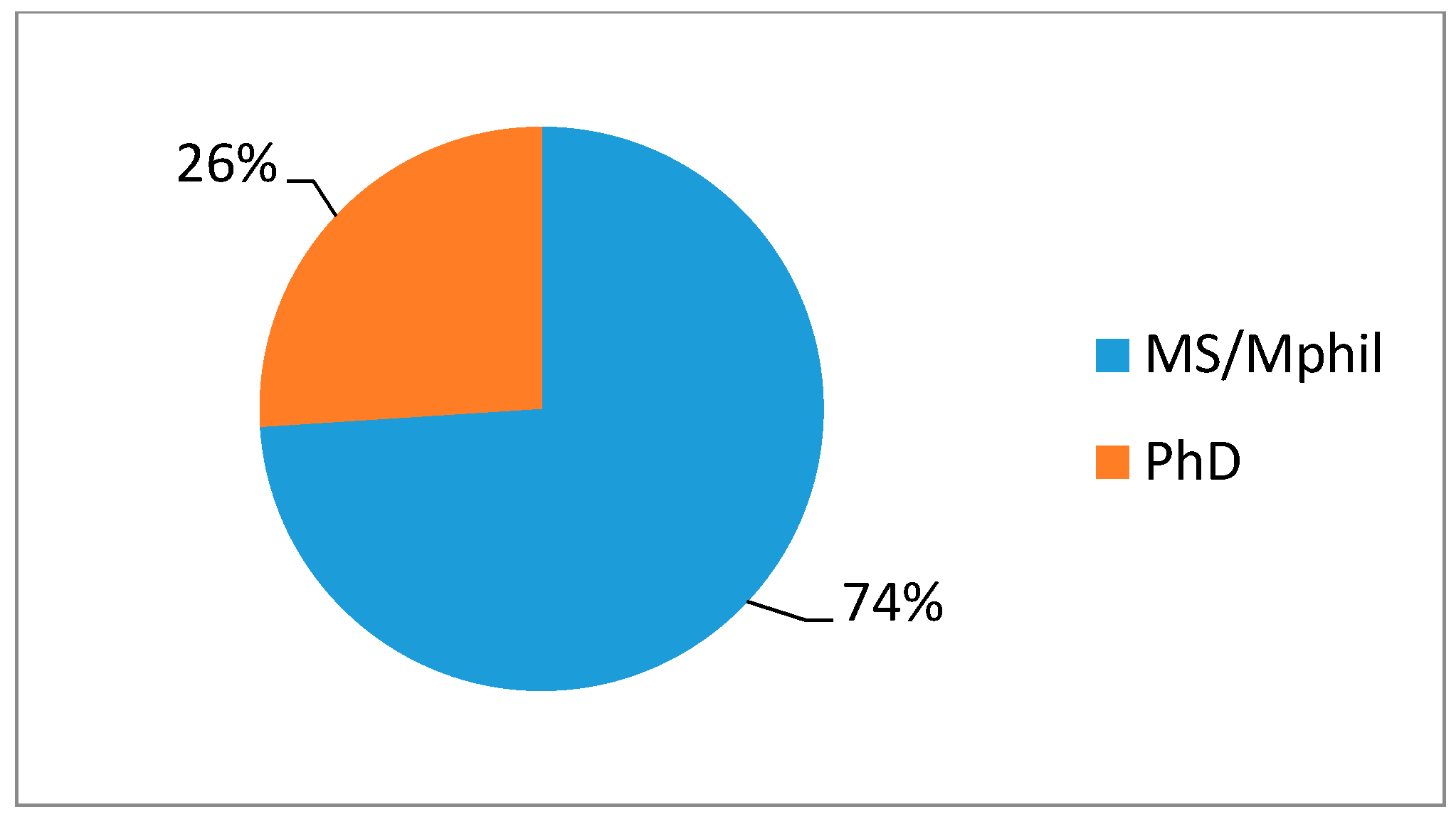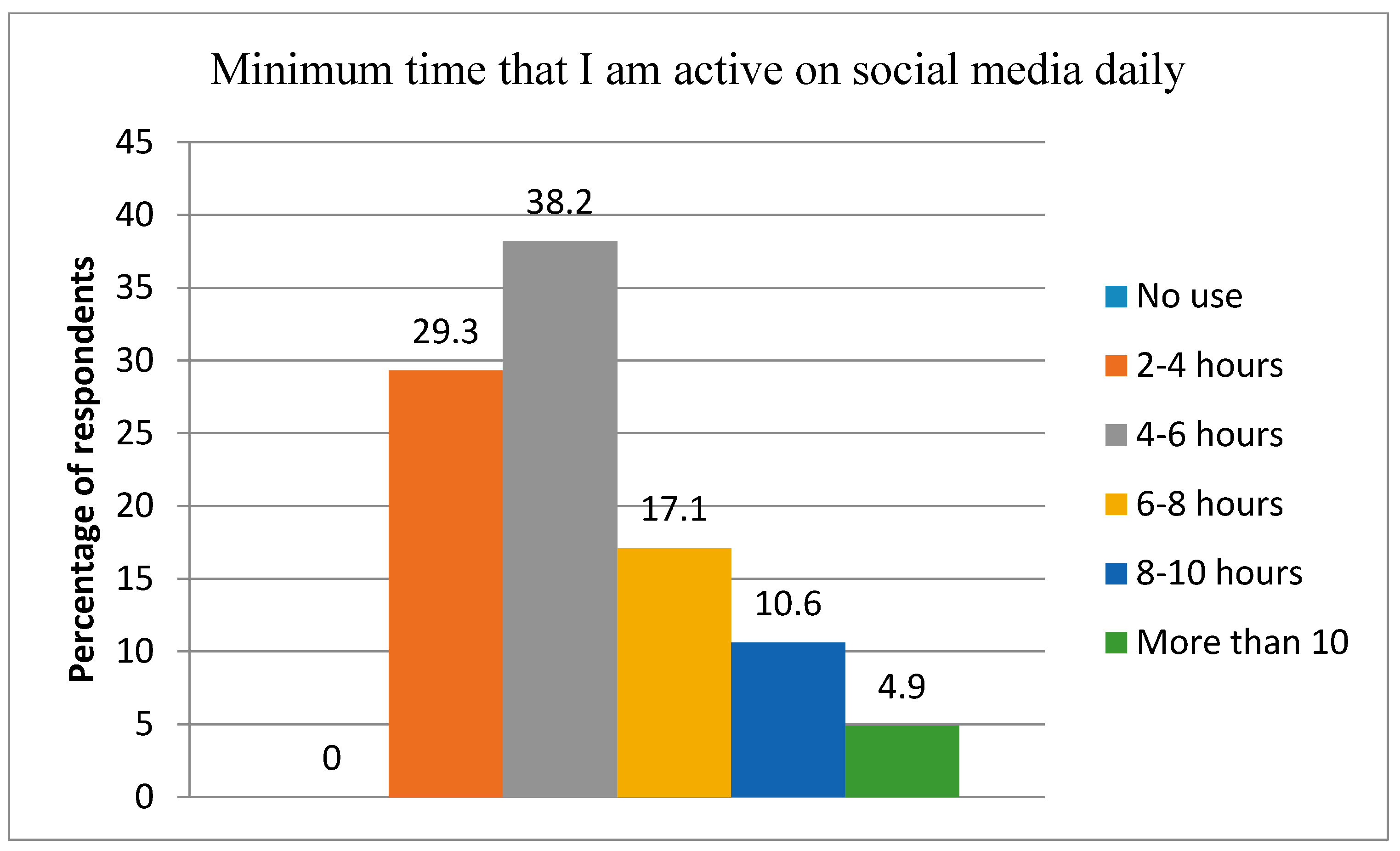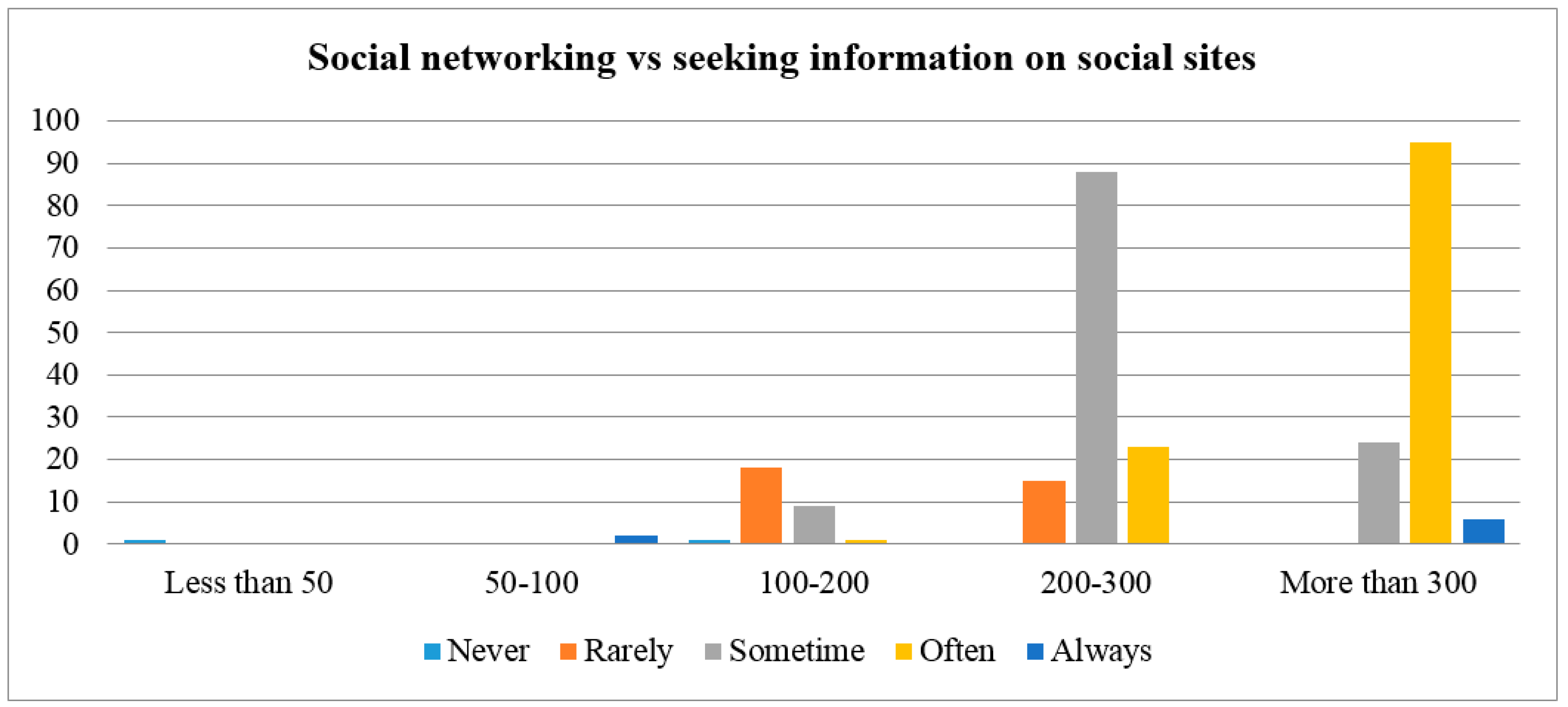1. Introduction
Social information has been the part of library and information science field since 1975 [
1], however, the trends have been shifting from fundamental social theories to social aspect of information and communication technologies. Previous research on social information has been categorized by Widen [
1] in three main phases from 1975 to 1989, then from 1990 to 1999 and the third phase took place since 2000 onward. In the third phase, the social information seeking (SIS) has emerged as field of study which focuses information not only from the user perspective but also from the perspective of social context and contents of social information. Social Information Seeking (SIS), however, is comparatively a new and emerging dimension of ISB that covers the seeking and acquiring information from social spaces on the Internet.
Social Information Seeking (SIS) in simple words refer to the communication and interaction (that mostly take place in the online environment between people) that influences human information seeking behaviour. It “involves studying situations, motivations and methods for people seeking and sharing information in participatory online social sites, such as Yahoo! Answers, Answerbag, WikiAnswers and Twitter as well as building systems for supporting such activities” [
2].
Human information interaction is generally believed to be a complex and multifaceted activity influenced by cultural, environmental, social/political and technological aspects. Research in the information seeking behaviour has taken three facets into consideration so far i.e., psychological aspect, social aspect and in-context aspect of information. Psychological aspect, aiming at general phenomenon about people looking for information, has dominated the field so far; while, the use of in-context and social approach is of growing interest to researchers in other fields [
3].
Connecting multiple users for information seeking continue, either to enhance existing information retrieval systems or to design the new ones. However, these systems are not yet adopted widely because of several known reasons and one of them is “wider visibility of collaborative systems” [
4]. Shah [
5] conceptualizes SIS in terms of five elements i.e., Information Behaviour, Information Retrieval, Social Networking, Social Media and Information Seeking. He further emphasizes that these elements must be in place for SIS to occur.
Participatory online social sites (including social networking and web 2.0 tools) are widely considered to improve collaborative learning among academia; however, there is a surprising lack of empirical research on social information in Pakistani higher education. Yet despite the importance of social interaction as a vehicle for information seeking, we know little about practices of social information seeking (SIS) and its impact on LIS research students in Pakistan. At the other hand, recent reports published on use of social media websites in Pakistan reveals that there are more than 30 million Facebook users as reported by Pakistan Telecommunication Authority on 15 November 2016 [
6].
Library & Information Science education is undergoing a rapid change in Pakistan since 2005. LIS schools have introduced research degrees and number of research students has been enrolled in LIS research degree i.e., MPhil/MS and PhD. The data was gathered from 123 research students currently enrolled in 7 LIS schools in Pakistan in order to assess their state of affairs regarding SIS trends.
3. Review of Related Literature
Social information seeking is a way in which information communication and dealings among people influence their information seeking. Social information seeking include four different procedures of finding information; collaborative search, interactive browsing, information warns and personalized information.
Previous literature suggests that Social Information Seeking represents different aspects with emphasis on supporting contemporary information behaviour not only connected to humans but animals also acquire useful information through social interactions. Widen & Holmberg [
1] divides literature on social information, according to broader perspectives, in three main categories i.e., user perspective, content perspective and context perspectives. This study, however, consider the user’s perspective of social information because the objectives are mainly concerned with it. Studies on social information from the users’ perspective focus on information needs and use. The social information includes both social cues (e.g., location of resource such as literary material) and public information (e.g., about the quality of literary material).
According to Wise, Alhabash and Park [
7] emergence of social information seeking is directed in the form of online question-answering (QA) websites which appears to constitute a specific virtual society. On-line community services such as Questioning & Answering and Yahoo! Answers facilitate their followers to make queries and retorted by the community.
The use of Social Q&A “an approach for people to seek and share information in participatory online social sites” is increasing day by day and youth of all ages are now more likely to seek and share information on online social spaces [
8] which not only recast information seeking patterns but also helps modify searching strategies. These services (gained popularity in the recent years) provide opportunity for users to acquire specific information and attain swift response to their academic, research, or everyday life questions [
9]. Participatory online social sites (POSS) like Facebook, LinkedIn, Twitter, Pinterest, Instagram and Google+ play a basic role to search and share current information. These sites also offer information seekers the opportunity to learn about the mentality of diverse people and cultures; thus, availing an opportunity to modulate their own information seeking behaviour.
Liu and Jansen [
10] pointed that “social information seeking activities are useful to understand user’s behaviours toward various features when they decide to interact and help others by responding to questions”. Online Q&A website not only help users to find prompt answers of their questions but also “added suggestions” is an advantageous tool to support users’ information behaviour. Morris, Teevan and Panovich [
11] describes that the recent increase in reputation of social networking sites such as Facebook, MySpace and LinkedIn has hosted some new choices to find information online, posting a question to one’s network. Social networking tools can help people to deliver questions to their social network to make it easy for people to quickly access some context on the topic.
With reference to influence on participatory online social sites on information seeking, most researchers, for example [
12,
13,
14] argued that virtual relationships offer increased learning and sharing opportunities. Whereas, several studies, such as [
15,
16] refers that web 2.0 and social media tools such as blogs and wikis are becoming more authentic sources for information seekers and that online social spaces are widely used platforms for multitask interactions. Studies [
17,
18] also show that video sharing receive 75% higher share rate while, image updates receive 98% higher engagement rate than other types of online information sharing.
Aguilar-Roca, Williams, & O’Dowd [
19] found that information seeking process (when taken up collaboratively by group) yields more fruitful results as compared to information seeking activity done individually. This not only points to another emerging area of research i.e., Collaborative Information Seeking but also establishes that QA websites enhance collaboration among researchers. Thus, social information seeking becomes a stepping-stone for online collaboration to occur. Social information seeking activities facilitate the followers to make queries and retorted by community. It gained popularity in the recent years and is giving birth to new virtual communities worldwide. SIS is causing change in the information seeking behaviour of people at large and is considered a useful tool to understand users’ information seeking strategies. It not only involves cognitive experience but also influence intragroup interactions.
Hyldegård [
20] found that people demonstrate collective cognitive experiences in participatory environment as an individual do in Kuhlthau’s IS model, thus concluded that intragroup interactions have strong influence on information seeking in the social spaces. Shah [
21] argues by quoting Evans & Chi [
22] that social interactions help in seeking and sharing information together. “They called this
social search. Such social ties leading to social search can be extended to stronger ties leading to collaborative search”. Scholars prefer to use social media to search contents for research and academic purposes and to develop new knowledge [
23]. At the other hand, Ganaie & Khazer [
24] argues that traditional resources have still great importance in academic activities for students as compared to participatory online social sites. However, most of the researchers in social science agree today that “knowledge not only exists in individual minds but also in discourse and interactions between individuals” see for example [
23,
25,
26].
Dillenbourg, Järvelä, & Fischer [
27] while talking on the topic of computer-mediated collaborative learning reveals that the era of 1995–2005 emerged as an era of growth of scientific community that developed engineering expertise and originated the life cycle of social interactions. The later era (since 2005) is characterized by integrated environment that brought a paradigm shift social interaction and information seeking in the digital and physical spaces, where multiple information seeking activities are performed with multiple tools. Now people refer to broadly use of social mechanism to find information online for example, the use of engine indexed social media and social tagging [
11].
Research on social networking shows that people spend more time on Social Browsing than on Social Searching [
7]. It means that social browsing is becoming more important activity on social networking sites than social searching. Similarly, information seeking (particularly for a researcher) is a multifaceted goal-driven activity and the information seeking behaviour is largely affected by the degree to which the information adds in goal achievement. Hence, it depends on the importance of goal that a researcher deploys greater number of strategies to information retrieval.
The role of social connections in pursuing information seeking is central and influences the decision-making of information seekers. Social browsing is “casual access to social links” and knowledge available through social interactions [
28].
Although, scholarly literature on the importance of SIS in the participatory online social sites (POSS) is numerous, however, the extent to which SIS practices have its impact on research LIS students remains unknown from the literature so far.
4. Material and Method
Data were collected using structure questionnaire administered to 200 research students currently enrolled in eight LIS schools in Pakistan, however, 123 complete responses for further analysis could be obtained. The questionnaire was administered via web link to the email addresses of the participants obtained from the respective departments.
The research instrument, comprised of 28 items, was partially adopted from the study conducted by Xu, et al. [
14] and was divided into two sections. Section one comprised of 5 demographic questions, while section two comprised of 23 questions on participants’ viewpoint regarding SIS practices, use of POSS for seeking information, use of social media and group discussion forum, information seeking pattern on social web and perceived level of change in information behaviour.
Factors such as number of social ties, collaboration and gender difference were also checked for possible influence on SIS of the population under study.
Survey items were designed to examine a holistic view of participants’ social information seeking practices based on the five basic components of SIS i.e., information behaviour, information retrieval, social networking, social media and information seeking as proposed by Shah [
2]. Respondents were requested to consider academics’ use of social media while answering the survey questions. Four questions on each of these 5 segments were asked, while 3 questions were on respondent’s viewpoint on how they perceive about SIS. Prior to conducting analysis, factor analysed for 20 items of the survey pertaining to 5 components of SIS corresponded to emphasis on Information Retrieval (IR), Information Behaviour (IB), Information Seeking (IS), Social Networking (SN) and Social Media (SM). The IR subscale (α 0.73) comprised 4 items and included a focus on perceived change in information retrieval practices. The IB subscale (α 0.76) contained 4 items and included perceived level of change in information seeking behaviour. The subscale IS (α 0.81) items assessing collaboration in information seeking, primary sources for academic information seeking and use of POSS. The subscale SN (α 0.85) focused on use of SNS for academic purposes and usage frequency for such reason. Finally, the subscale SM (α 0.82) included items to focus the respondent’s use of social media channels for academic and research purposes. Responses for these items ranged from 1 “never” to 5 “always” and scores were summed to obtain total score for each respondent and then averaged across four items to get aggregate for each individual variable. Items were coded to ensure that higher scores reflect greater levels of SIS practice. The higher the total score, the higher the practice of academic information seeking of the survey participants from online social spaces.
All the participants of this survey had a good level of proficiency in using social web and were enrolled in research degree (i.e., MPhil/MS or PhD) in different universities around the country. Parametric and non-parametric tests were conducted to assess possible association between variables using IBM SPSS (Statistical Package for Social Science) version 19.0 [
29].
7. Conclusions
Social information seeking incorporates different aspects of social context of information need, social ties (online social networking) and channel of communication (e.g., social media and web 2.0 tools). There are five elements that must be in place for SIS to occur and this study attempted to investigate all these elements individually in the Pakistani LIS graduates to assess their level of understanding and practice of SIS especially for research and academics.
Data analysis show that LIS research students in Pakistan make the utmost use of social spaces for information seeking especially for research and academic purposes. Collectively, 67% research students are active on social web for about 2 to 6 h while remaining of the participants were active around 6 to 10 h daily. Research community has different information practices and priorities related to academic and research needs and statistical results of this study indicated that information behaviour of research students can be predicted by their use of social information seeking. Results of the study reveals an association between number of online social connections of the participant and the SIS practice of the respondent. Increased number of social ties increases the confidence of a research student to seek information on social sites. Similarly, it is also concluded that change in the strategies/ways to retrieve information from the social websites depends on the social information seeking practices of the research students. Thus, SIS practices help to clarify directions in information retrieval strategies of the research students. The study further concludes that there is not enough evidence to suggest an association between amount of time spent on social media and social information seeking practice of the research students. Thus, time spent and usage frequency of social websites does not affect one’s SIS practices and the use of social websites for information seeking varies depending on the context of information.
Collaborative information seeking practices are also advocated by those who always use participatory online social sites for information seeking. Online discussion groups have gained much popularity in the recent times worldwide. Our results revealed that majority of participants who are active in using online discussion groups strongly perceive that it helps in reshaping the information behaviour in collaborative environment thus contributing to overall increase in the SIS activities of a research student.








